- Home
- Encyclopedia
- William Henry Jackson: Foremost Photographer of...
William Henry Jackson: Foremost Photographer of the American West
Before snapshots, photography was difficult, technical, cumbersome—and reserved for experts like William Henry Jackson. But Jackson’s influence on the public perception of the American West, including large areas of Wyoming, was enormous.
During his lifetime he sold thousands of prints, provided a library of images to the U.S. government under the auspices of what became the United States Geological Survey, and was profiled in such major photography magazines as The Philadelphia Photographer, Wilson's Photographic Magazine, The Photographic World and Anthony's Photographic Bulletin. The Rand McNally Company also published his photos in their early guidebooks.
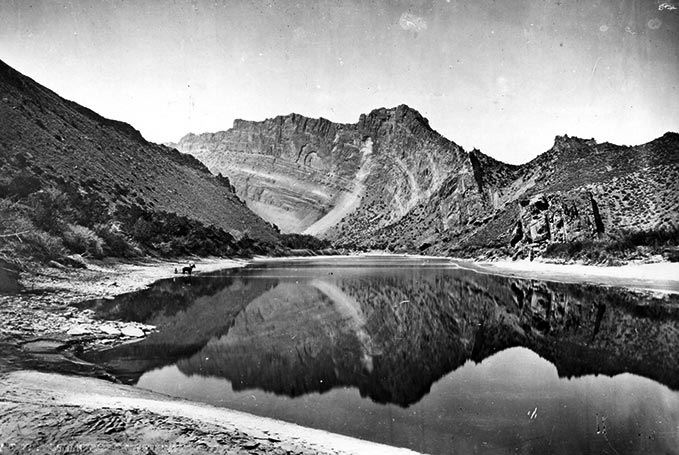
Born in Keeseville, in upstate New York, on April 4, 1843, Jackson began drawing and painting before he was 10 years old, encouraged by his mother. Harriet Allen Jackson, a graduate of the Troy Female Academy, had continued the watercolor painting she'd learned in school, and gave her son a copy of J. G. Chapman's American Drawing Book. According to Jackson's autobiography, Time Exposure, he drew or painted every day "with a burning zeal." At 15, he earned money retouching prints in professional photography studios, first in Troy, N.Y., and later in Rutland, Vt.
In September 1862, at 19, Jackson joined the Union Army, where his drawing and painting talent gained him work drawing maps and sketches of fortifications. After returning home in July 1863, he resumed his retouching work in Rutland. Near the end of 1864, he took a job in Burlington, Vt., at A. F. Styles's Vermont Gallery of Art, earning $25 per week, almost double his salary of the previous year.
First trip west
Despite this professional progress, Jackson was restless enough to break away and travel west in the early summer of 1866. Hired as an ox-train driver or "bullwhacker," he worked his way to Salt Lake City, Utah, by October 30, finding time to sketch and draw along the route through Wyoming Territory. His developing artist's eye caught the beauty of his surroundings; he noted in a July 30 diary entry, "The scene we presented was worthy the [sic] pencil of Rembrandt. It was shortly after sunset and the heavy, massive thunder clouds were lit up with a dull lurid light ... it was just dark enough to make a fire show brilliantly."
In Salt Lake City, suffering from frostbite and nearly out of money, Jackson was finally able to travel to Los Angeles, where he found another job, this time driving wild horses east with an expedition that left Los Angeles on May 2, 1867.
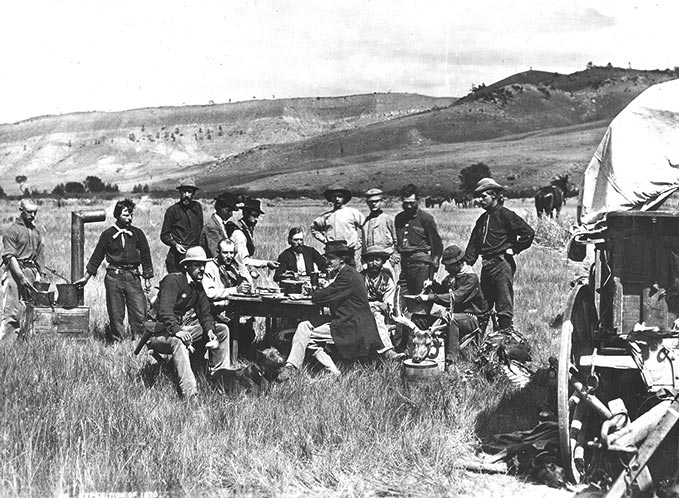
Two months later, he stopped in Omaha, Neb., the eastern terminus of the Union Pacific, booming as construction began on the road. Jackson found a retouching job at one of the city's largest photographic studios, run by Edric Eaton Hamilton. A year later, financed by his father, Jackson bought Hamilton out and opened Jackson Brothers, Photographers, with his brothers Ed and Fred. By 1869, he was well established. Already he had photographed Pawnee and Omaha Indians in the area surrounding the city. To these subjects he added landscapes, towns and people along the UP line as far west as Promontory Point, Utah Territory, at the junction of the Union Pacific and Central Pacific railroads.
With the Hayden survey
When U.S. Geologist Ferdinand V. Hayden walked into Jackson's studio in July 1870 in search of a photographer to join his expedition to survey as much of Wyoming Territory as he could in one season, the two men quickly closed the deal. Fortunately, Jackson could leave his studio in the capable hands of his wife, Mollie Greer Jackson, who had been helping him run the business after the departure of Ed and Fred in fall 1869.
Hayden, a medical doctor and former professor of geology at the University of Pennsylvania, was a seasoned explorer and had conducted a survey of Nebraska in 1867 using $5,000 provided by the U.S. General Land Office. This, plus Hayden’s subsequent trips, which spanned 11 years and covered much of the Rocky Mountain region as far south and west as New Mexico and Arizona territories, became known as the Hayden Survey, one of four western surveys eventually combined into the U.S. Geological Survey.
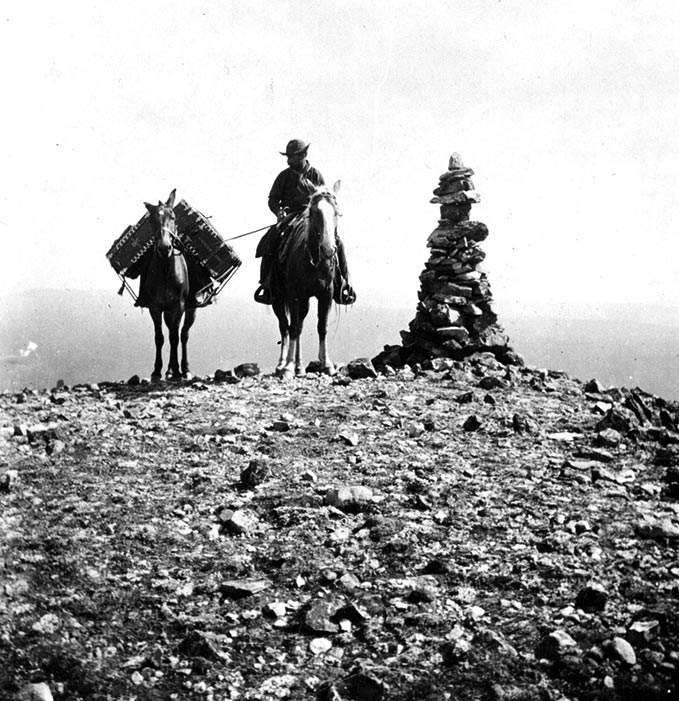
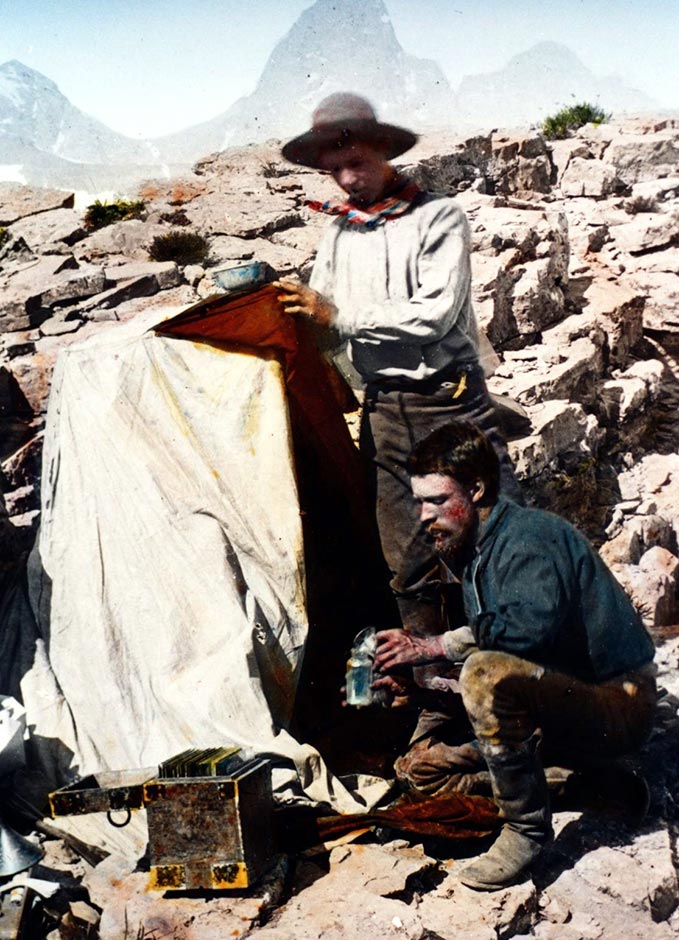
At first glance, Hayden's offer to Jackson seemed unappealing because Hayden could not pay a salary, just outfitting expenses, traveling costs to and from Cheyenne, Wyo., the survey's starting point, and all necessities during the survey.
However, Jackson's biographer, Peter Hales, notes that "Jackson's deal with Hayden was far better than it seems … as unpaid correspondent, he was permitted to retain any negatives he made." Therefore, Jackson could sell prints to the public and government offices other than the survey, and also use the survey stamp and Hayden's name as he wished. "Protected transportation … into some of the most important regions of the West," Hales concludes, was also a major advantage.
The wet-plate process
Transportation took on added significance because of the amount of equipment Jackson had to carry just for basic photography. The technology of the time was the wet-collodion process: First, the photographer had to light-sensitize his future negative, a plate of glass, in a darkroom or dark box or dark tent, as Jackson used in the field, with a collection of bottled chemicals, including nitric acid and silver nitrate. Then he made his exposure, usually by removing the lens cap. Last, he developed the negative. Hales adds, "Plates were developed, fixed, washed, dried over an alcohol lamp, and then varnished to protect the image―all within minutes of the exposure."
Twenty minutes from start to finish was the maximum time possible for working with wet plates, and this could be less, depending on the weather. Jackson's whole outfit weighed not less than 300 pounds and included at least 42 separate items such as trays for washing, toning and silvering; ink and brushes for retouching; and scales and weights for measuring chemicals. To protect his glass plates, he used parfleches—bags made of rawhide soaked in lye to remove the hair, then dried. Later in his career he switched to leather cases.
From August 7 until November 1, Hayden's 1870 party explored central and southwest Wyoming Territory largely along the old Oregon Trail route, by way of Red Buttes near present Casper; Independence Rock and Devil's Gate; Split Rock; Atlantic City and South Pass City; and the Flaming Gorge region south of the present-day town of Green River. On this expedition, Jackson took more than 200 photographs, according to the Descriptive Catalogue of The Photographs of the United States Geological Survey of the Territories. Eventually, many of the 1870 photos and later ones were widely circulated to a commercial market by the Detroit Photographic Company.
In Time Exposure, Jackson commented on the rigors of the 1870 trip, "for every mile on the map we covered between two and three on the ground―up mountainside, down stream bed, across country."
Following the survey, Hales notes, Jackson was offered the position of "official photographer to the [Hayden] Survey, at a year-round salary, with offices and a darkroom in Washington." By spring 1871, when Hayden's report was circulated, Hales continues, Jackson was "a vital element in Hayden's ... organization."
Yellowstone
On his next survey, Hayden explored the Yellowstone region, setting up a base camp near Mammoth Hot Springs in July 1871, according to historian Aubrey Haines. By July 28, the party was at Yellowstone Lake. They reached the Upper Geyser Basin a few weeks later.
Returning to the East in early October, Hayden and his men joined the lobbying effort that probably played a significant role in the passage of the Yellowstone National Park Act of 1872. Haines reports that Hayden had "geological, botanical, and zoological specimens, sketches, and photographs," some of which he placed on exhibit for members of Congress.
Were Jackson's photos the decisive factor in the passage of the legislation? Probably not, and this point is well argued by Howard Bossen in a 1981 paper presented to the Annual Meeting of the Association for Education in Journalism. Bossen does concede that Jackson's photos, as part of Hayden's larger exhibit, contributed to the growing body of evidence that the area was a natural wonder.
The Hayden Survey returned to the Yellowstone region in summer 1872, splitting into two parties, one led by Hayden, and the other by James Stevenson, Hayden's second-in-command from the 1870 expedition. Jackson, with Stevenson's party, explored the western side of the Teton Range in present-day Idaho.
Jackson remained with the Hayden Survey until 1878, its final year. That year, Hayden returned to northwestern Wyoming Territory. The party departed from Cheyenne on July 24 and then traveled to South Pass and through the Wind River Mountains to present-day Jackson Hole, which was not named for William Henry, but for trapper and mountain man David Jackson, no relation. From there, the Hayden group entered Yellowstone Park.
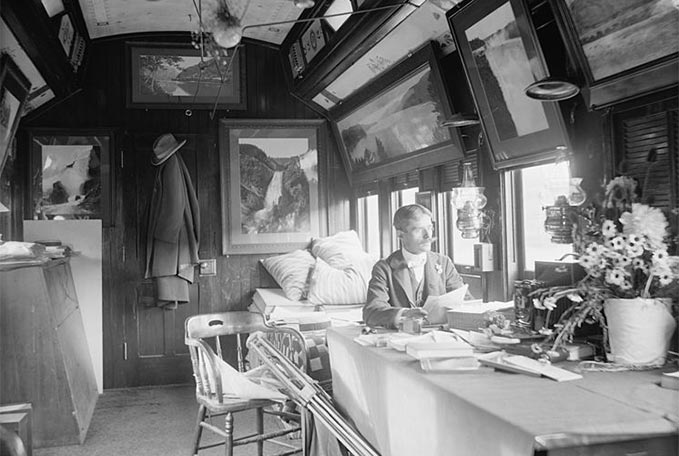
Commercial photography
In 1879, Jackson set up a studio in Denver, Colo., and settled there with his family. Mollie, his first wife, had died in childbirth along with their infant daughter in 1872, and Jackson had married Emilie Painter in 1873. They had three children, Clarence, Louise and Hallie. At 18, Clarence joined his father in the business until it began to totter in the nationwide financial panic of 1893.
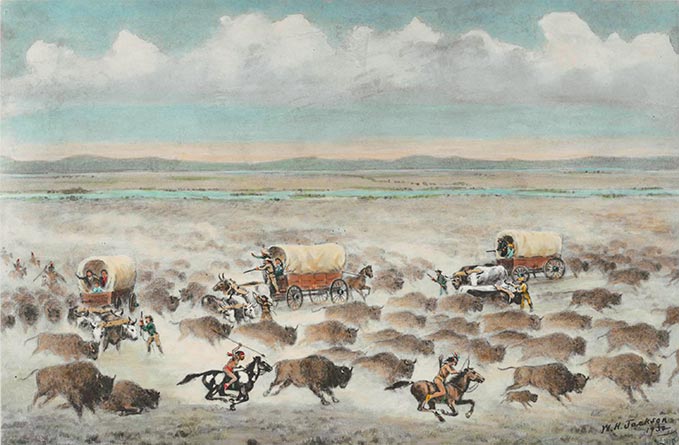
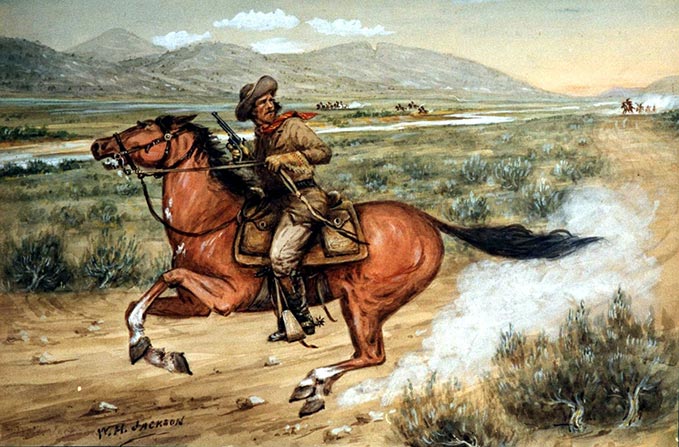
Also affecting many commercial photographers were big changes in technology. The roll-film Kodak camera, introduced in 1888, opened the field to amateurs. But innovations in mass reproduction of half-tone photographs—those taken with a special screen to produce gray tones as well as the traditional black-and-white—made photos much cheaper than wood engravings for use in mass-circulation newspapers and magazines.
Jackson, seeking new avenues for his work, and needing to bolster his business in Denver, spent the fall of 1893 photographing the World Columbian Exposition in Chicago, Ill. Next, he embarked on a two- year, worldwide tour sponsored by the World's Transportation Commission, visiting the Near and Far East, China, Australia, Russia and Siberia.
“Resident pioneer”
In 1898, Jackson moved to Detroit and joined the newly formed Detroit Photographic Company, where he remained until his retirement in 1924, at 81. The final chapter of his life was spent writing his memoirs, painting and serving as a kind of pioneer symbol—almost a grand old man—of the American West.
This latter role began when Robert Ellison, owner of the Midwest Oil Refining Company in Casper, Wyo., invited Jackson to visit Wyoming in the summer of 1925. Ellison, an amateur historian of the West, had acquired a portfolio containing some of Jackson's early photographs. Ellison began to purchase Jackson's paintings, and paid him $150 for a fictitious rendition of the so-called Battle of Red Buttes, near Casper. Through Ellison, Jackson soon acquired other patrons, including A. J. Durlacher of the Mena Grande Oil Company of Maracaibo, Venezuela, and Howard Driggs, president of the Oregon Trail Memorial Association, and co-author, with Jackson, of Pioneer Photographer, a book for boys about Jackson.
This period in Jackson's life marks a clear shift in his artistic vision. Hales notes that Jackson "found a ready market for his paintings but paid a price for it"—in the integrity of his work.
Whereas in his photography and earliest paintings, he was an accurate, often inspired, recorder of landscapes, people and buildings, his later paintings generally have a narrative intent—they mean to tell stories—but they show events he never witnessed. For example, Buffalo Stampede shows a Nebraska scene along the Platte River with Indians in the foreground and covered wagons among hordes of running bison. Even though the background of Buffalo Stampede is a panorama of sky and hilly country, the painting lacks the quiet, uncluttered feel of so many of Jackson's western landscape photographs.
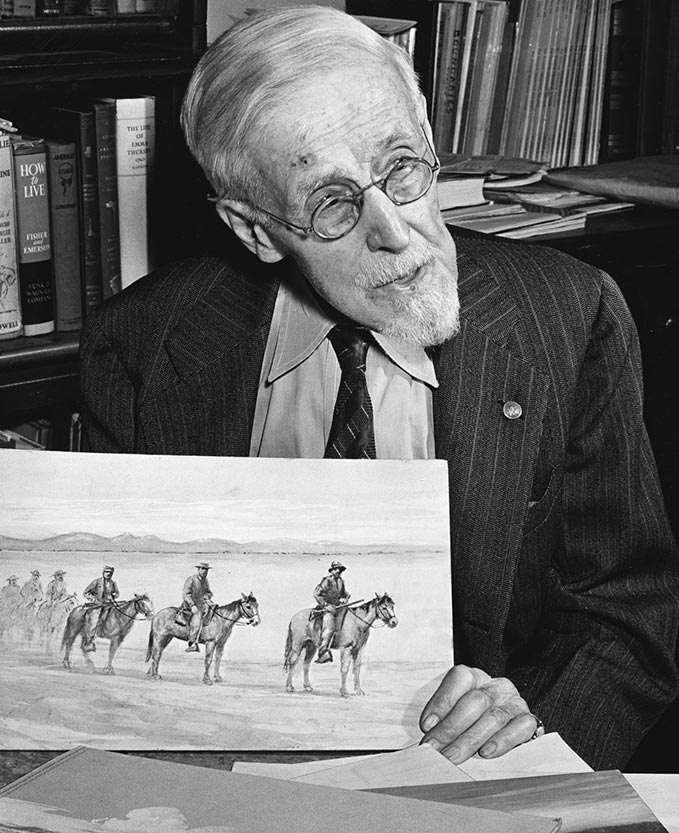
Yet Jackson did even more to perpetuate the romance of the American West than produce impressive photographs and paint action-filled, imaginary scenes. The Oregon Trail Memorial Association, founded in 1926 by trails promoter Ezra Meeker and others, hired Jackson as research secretary in 1929. Hales comments that after Meeker's death, Jackson, in addition to spending some time on research, "became” at the age of 86, “the organization's resident pioneer." No doubt, his early experiences with the Hayden survey and before that as a bullwhacker and herder of wild horses added to his aura of Old West romance in the eyes of Association members.
Jackson traveled to the West for public appearances at historical society meetings, Western history conventions, festivals, trail treks and holiday events. He was "trotted out," Hales notes, "to give a slide talk, [or] more often to say a few words or even simply stand on the podium or wave from the open car in some parade."
Jackson died on June 30, 1942, at age 99, and was buried at Arlington National Cemetery in Washington, D. C. Having spent his early career creating powerful images that conveyed a true sense of the beauty and size of the West, a huge achievement, William Henry Jackson late in his life became a willing promoter of the myths of western action, adventure and romance. These efforts place him right in line with the dime novelists and wild-west-show promoters who preceded him, and in company with the many film directors by then offering these myths to the masses.
Over a lifetime during which the West may have changed more than ever before or since, however, he remained a photographer. When he started taking pictures, he needed a wagonload of equipment. Fairly quickly he reduced that to a load a pack mule could carry. Yet before he died, he was making color pictures with 35 millimeter film in a Leica camera.
Resources
- Bossen, Howard. "A Tall Tale Retold: The Influence of the Photographs of William Henry Jackson upon the Passage of the Yellowstone Park Act of 1872." Paper presented at the annual meeting of the Association for Education in Journalism, West Lansing, Mich., August, 1981. Accessed April 12, 2014, at http://files.eric.ed.gov/fulltext/ED204767.pdf. (For best results, paste url directly into address window on browser.)
- Hafen, LeRoy, and Anne W. Hafen, eds. The Diaries of William Henry Jackson, Frontier Photographer. Vol. 10. The Far West and the Rockies Historical Series 1820-1875. Glendale, Calif.: The Arthur H. Clark Company, 1959, 57. This volume covers in detail Jackson's 1866-67 trip from New York to California and back, and also his travels with the Hayden Survey to the Central Rockies in 1873-74.
- Haines, Aubrey L. The Yellowstone Story: A History of Our First National Park. Vol. 1.
- Yellowstone National Park, Wyo.: Yellowstone Library and Museum Association, 1977, 144, 153.
- Hales, Peter B. William Henry Jackson and the Transformation of the American Landscape. Philadelphia: Temple University Press, 1988, 30, 71, 85, 89, 286, 287.
- Jackson, William Henry. Time Exposure: The Autobiography of William Henry Jackson. 3rd ed. Tucson, Ariz.: The Patrice Press, 1994, 20, 22, 189, 191. First published 1940.
- Rea, Tom. Devil’s Gate: Owning the Land, Owning the Story. Norman: University of Oklahoma Press, 1976, 137-154.
- United States Department of the Interior. Descriptive Catalogue of the Photographs of the United States Geological Survey of the Territories for the Years 1869 to 1875, Inclusive. Miscellaneous Publications No. 5. Washington, D.C.: 1875. Accessed May 16, 2014, at https://archive.org/details/descriptivecatal00jack.
- Wilson, Edward L., ed. Wilson’s Photographic Magazine. New York: published by Edward L. Wilson, 1894. vol. xxxi, p. 441. Accessed May 26, 2014 at http://books.google.com/books?id=BvbNAAAAMAAJ&pg=PA5&source=gbs_toc_r&cad=3#v=onepage&q&f=false.
For Further Reading
- Blair, Bob, ed. William Henry Jackson's "The Pioneer Photographer." Compiled, edited, and annotated by Bob Blair, with original text from the 1929 edition by William Henry Jackson in collaboration with Howard R. Driggs. Santa Fe, N.M.: Museum of New Mexico Press, 2005. A coffee-table edition of Jackson's memoir for boys, The Pioneer Photographer, with Jackson's photographs, paintings and drawings on almost every page plus Blair's annotations to the original text. A good example of a useful annotation is found on p. 86: "Many photographs taken in Jackson Hole by William Jackson are reported as having been taken in 1872. No photographs taken in Jackson Hole were created until 1878 or later. None of Jackson's records indicate he crossed the Teton Range to the east in 1872. He delineated his routes for both 1872 and 1878 on a Grand Teton National Park map."
- Jackson, Clarence S. Pageant of the Pioneers: The Veritable Art of William H. Jackson. Minden, Neb.: The Harold Warp Pioneer Village, 1958. Compiled by William Henry's son, this 89-page collection includes mostly paintings, plus memorabilia such as a daguerreotype Jackson made of his first sweetheart, Caddie Eastman, and pencil sketches of scenes from his travels in 1866-1879. The paintings, though interesting and well done, are almost certainly not "free of any exaggerated or phony situations," as Clarence Jackson claims in his foreword. Rather, as scenes William Henry never witnessed, such as battles with Indians, they are a study in how Jackson painted to suit his patrons.
Illustrations
- The 1902 photo of Jackson aboard the Detroit Photographic Co.’s special train is from the Library of Congress, via Wikipedia. Used with thanks.
- The tinted photo of Jackson and an assistant at their dark tent on the west side of the Tetons, 1872, the painting of the Pony Express Rider and the photo of Jackson in his nineties are all the from the William Henry Jackson Collection, Scotts Bluff National Monument. Used with thanks.
- Jackson aficionados--and anyone who has spent a lot of time in the Tetons--will notice that the tinted photo of the two men at the dark tent is also reversed (and significantly cropped) from its black-and-white original. Our thanks to Alan Terrell of Junction, Tex. for alerting us on this.
- The image of Jackson’s painting, “Buffalo Stampede,” is image number WHJ-10610 from the Western History Collection, Denver Public Library. Used with permission and thanks.
- Jackson’s photos of Flaming Gorge, the rider with the pack mule on Mount Washburn, Natural Bridge, the Hayden Survey near Red Buttes, Devil’s Gate, Split Rock on the Sweetwater and Wind River Peak in the Wind River range are all from the United States Geological Survey Library. Used with thanks.
- For a gallery of Jackson’s early photos of Yellowstone Park, see the WyoHistory.org article, “Yellowstone, the World’s Wonderland” by Tamsen Emerson Hert at /encyclopedia/yellowstone-national-park.
